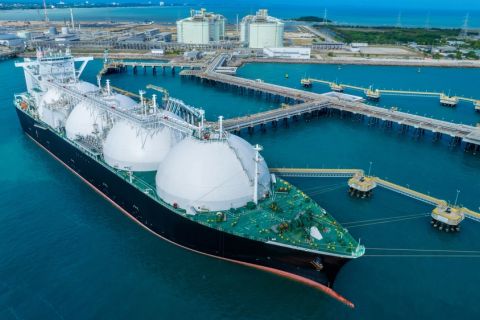Once a quiet, almost forgotten corner of the energy industry, the midstream sector is one which has transformed itself in the last two years as the industry has realized its infrastructure is inadequate to bring a growing number of new reserves to market. The renewed activity has captured the attention of investors, who have started flocking into the sector in search of portfolio diversity, stable yields and steady growth.
A recent study from Houston-based Tudor, Pickering, Holt & Co Securities, Inc. shows the midstream sector has become a formidable target for investors. "Capex dollars, M&A activity and historically low yields indicate that the North American midstream is sharing in the unconventional resource boom," says Brad Olsen, the company's vice president of midstream research and the lead analyst of the report.
"As a result, midstream companies are leveraging existing assets and securing long-term commitments on previously under-utilized infrastructure, and we want in," he says.
Midstream investors almost universally turn to the sector to diversify their portfolio, seeking stable and growing returns from stable companies with a high yield. But the most common legal structure for many midstream companies, the master limited partnerships (MLPs) makes it difficult to attract many institutional investors that often bring in large amounts of capital and liquidity.
To attract this capital, investment funds that specialize exclusively in midstream MLPs have emerged and captured the attention of a growing number of institutional and individual investors.

“Capex dollars, M&A activity and historically low yields indicate that the North American midstream is sharing in the unconventional resource boom.” — Brad Olsen, vice president of midstream research, Tudor Pickering Holt & Co. Securities Inc.
Fee-based revenue
Brian Watson, director of research for Dallas-based SteelPath Capital Management LLC, says the investor generally prefers companies that generate revenue from fee-based services rather than those with revenues based on commodity prices. Commodity-based income streams are inherently riskier because the value of those assets can go down as easily as they can go up.
"We think the MLP space is attractive because it is home to pure-play energy infrastructure companies, not just because these companies are structured as partnerships. We believe these entities offer the attractive and unique value proposition of above average total return potential combined with low underlying business risk," he says.
Although some more commodity-sensitive MLPs may do well if commodity prices rally, SteelPath's value proposition is to focus on businesses with a strong fee-based revenue stream. SteelPath believes the sector as a whole will continue to grow over the next decade and offers an attractive risk-reward profile to investors.
"What's interesting about this sector is that it's home to the pure-play pipeline business. You can find companies with really low business risk which, for a number of reasons, are growing at attractive rates. This makes a very attractive risk-reward profile," he says.
MLPs frequently attract income investors who are looking for a steady distribution. As a result, the price of MLPs units tend to track distribution rates. For this reason, SteelPath looks for companies with fee-based revenues that generate a steady and reliable flow of cash. "If you're going to play in the MLP space, go for the fee-based players. Take your commodity risk elsewhere," he says.
An MLP which draws a significant portion of its revenue from exposure to commodity prices will likely see its unit price rise when commodity prices move favorably, but its price may not rise as much as an upstream company with similar commodity exposure would.
On the other hand, if investors pick an MLP with a significant exposure to commodities and those commodity prices move adversely, that MLP may be forced to cut its distribution and the market will likely punish the company for the reduction. An MLP which cuts its distribution by 15% or 20% could see its price fall by two or three times that amount, Watson says.
Primarily, MLPs trade on a multiple of their distributions, and where their distributions are expected to go. When the distribution falls, the multiple can fall as well, resulting in an important impact on the unit's price.
Typically, MLPs trade at higher multiples than upstream and other energy companies, with one exception: Exploration and production MLPs in mid 2007 through the financial crisis saw their multiples fall when the sector fell out of favor and some cut their distributions. The market responded by reducing the multiple for the sector, Watson said. Since then, their prices have recovered as the market's nervousness over the distribution cuts have abated.
Some of the larger holdings in SteelPath's portfolios are Buckeye Pipeline Partners LP (BPL), Enterprise Products Partners LP (EPD), Oneok Partners LP (OKS) and Holly Energy Partners LP (HEP). These companies have exhibited the steady fee-based revenue stream that SteelPath prefers.
Almost every MLP in the midstream sector will stress its fee-based revenue structure to attract investors, but some assets are inherently more risky than others. An MLP that owns mostly pipelines but also has processing plants will likely have some commodity exposure from the natural gas liquids produced by that plant, so SteelPath has assembled a series of financial models based on each company's assets to determine which really are the best fit for its investors.
A company may have fee-based revenues on 90% of the volumes it handles and only 10% of its volumes may produce commodity sensitive margins, but that 10% may account for an outsized portion of total profit margin, Watson says. An adverse movement in the commodities that it processes would have a severe effect on its profits and potentially its distribution. To filter those companies out, SteelPath uses a sophisticated asset-based financial model.
Three mutual funds
SteelPath started in the MLP sector under the name Alerian Capital Management in 2004—the same year the first investment funds focused in MLPs came out. Alerian Capital Management, based in Dallas, originally only offered funds available privately to qualified investors. The sector did not have an index, so in 2006, Alerian created an index even as it continued to mange investments in the sector.
In 2009, Alerian launched an exchange-traded note based on its index and licensed its use to J.P. Morgan & Co. Gabriel Hammond, who founded the company, realized he had two separate businesses: One is an index of the sector, and the second is an actively managed investment firm in the midstream sector. He renamed the fund management business SteelPath and kept the Alerian name for the index because it was so well known.
SteelPath has three publicly traded mutual funds which tend to attract more institutional investors while its private-equity funds are almost exclusively high-net-worth individuals. Its Alpha and Income funds target 20 names each, while its Select 40 fund targets 40 companies. Average position sizes in the funds are about 5%. SteelPath has a total of $1.7 billion in assets under management, with $1.3 billion in mutual funds and the rest in privately offered funds.
SteelPath uses a quantitative analysis to determine which companies best meet its investment criteria. It uses a sum of the parts valuation method to determine its long-term price target. To ensure it is incorporating all of the risks in its potential portfolio holdings, Watson also uses a stress-case scenario to avoid those MLPs which have a significant exposure to commodity prices.
"Commodity-price exposure is often disregarded by the market when prices are firm, but this exposure can have a devastating impact on unit prices when commodity prices correct," he says.

“We believe these entities offer the attractive and unique value proposition of above average total return potential combined with low underlying business risk.” — Brian Watson, director of research, Dallas-based SteelPath Capital Management LLC
Changing growth dynamics
Only a few years ago, growth in MLPs was almost entirely based on the migration of assets from integrated corporations into an MLP structure as production of oil, natural gas and natural gas liquids was slowly declining. Since then, things have changed. The use of horizontal drilling techniques and fracturing technologies has caused growth in production of all three of these hydrocarbons. This growth in production is expected to have a significant long-term impact on the outlook for the midstream sector as a whole.
"Those midstream MLPs best able to capture incremental growth opportunities by solving the logistical concerns of the producer and consumers of energy while maintaining financial discipline and avoiding excessive commodity-price exposure will do very well, " Watson says. "We look to position our portfolios accordingly."
Production from shale and other unconventional plays has indeed captured the attention of investors, but those who are interested in incremental supplies tend to invest in the upstream rather than midstream, says Watson.
"I don't think we get a lot of calls from investors who say 'Shale plays are awesome, I want to invest with you because of that,'" he says. But the additional crude, gas and condensate production from unconventional sources is having an indirect effect on midstream.
"These otherwise boring cash-cow type of companies are growing at attractive rates as volumes through their assets improve. On top of that, MLPs are building new assets to meet producer and consumer logistical needs," he says.
In addition, the potential to acquire midstream assets from integrated oil companies which own midstream assets is sizable. These companies generally trade at five to six times EBITDA, while midstream MLPs trade at 10 times EBITDA and sometimes higher.
It makes perfect sense for these companies to spin off their midstream assets into an MLP and capture the incremental value in the form of a higher trading multiple, Watson says. "The basic economics of pushing assets into midstream MLPs is a third source of growth."
Two funds
Like other funds, New York city-based ClearBridge Advisors LLC's two MLP funds focus on companies with steady, predictable cash flows from fee-based revenue streams, says Chris Eades, portfolio manager and managing director. The firm limits exposure to companies with high levels of direct commodity-price exposure.
ClearBridge Advisors is a wholly owned affiliate of Legg Mason Inc., and has about $60 billion in equity assets under management. Almost $3 billion is invested in MLP equities. It has two publicly traded closed-end MLP funds.
ClearBridge Energy MLP Fund launched in June 2010 and trades under the ticker CEM with roughly $1.8 billion in assets. Clearbridge Energy MLP Opportunity Fund launched in June 2011 and trades under the ticker EMO with about $750 million in assets.
Clearbridge Energy MLP fund is a diversified MLP offering exposure across the universe of MLP stocks. Clearbridge Energy MLP Opportunity fund, meanwhile, has a strong focus on crude oil and natural gas liquids infrastructure. The second fund was launched to leverage the increasing U.S. oil and natural gas liquids production from new shale plays that will require incremental infrastructure to bring the production volumes to the market.
"We feel one of the strongest attributes of the asset class is the stability and predictability of the cash flow," says Eades. "When you have an MLP with a lot of commodity price exposure, cash flows become far less predictable. We tend to focus on companies that have more predictable cash flow streams than an upstream producer would have, and, to a lesser extent, than some of the gathering and processing companies would have," he says.
While virtually all MLPs stress their fee-based revenue structure, some have more exposure to commodity-price fluctuations than others. Discerning the two requires a study of their underlying assets and a sound knowledge of the dynamics of U.S. energy markets.
"During the past two to three years, we've seen these companies gravitate more toward a fee-based business model and less on playing the spread between natural gas and natural gas liquids prices. That shift is likely to continue over time. We really don't need nor want that commodity-price exposure to achieve the investment objectives of our funds. To the extent that we can eliminate it, we do," he says.
Eades has managed quite a few traditional energy company assets and is comfortable taking on commodity price risks in the upstream sector, but doesn't believe that taking on that risk is appropriate within their MLP strategies. Most of its investors seek steady returns and consistent growth in distributions, he says.
MLPs are a small but growing niche of the investment universe, explains Eades. Today there are more than 80 publicly traded MLPs, up from 70 a year ago and 20 a decade ago. Most analysts expect this number to continue to grow. "The reality is that, given the limited number of names, MLP portfolios are relatively concentrated," he says.
To build his portfolio, Eades starts with this list of 80 potential targets and starts narrowing them down by their exposure to commodity prices. Those with too much exposure get whittled away as potential targets. A second factor is liquidity. Not all of the 80 publicly traded MLPs are as liquid as most large public corporations and Eades does eliminate some MLPs for lack of trading liquidity.
From a list of roughly 50 appropriate names, Clearbridge currently has 31 holdings. Some of the favorites within the larger MLP fund include Enterprise Product Partners, Energy Transfer Equity LP and Linn Energy LLC. The latter is actually an upstream company that has 90% of its production hedged for four years, leaving limited exposure to commodities and an appropriate holding for the fund's investors.
Most upstream companies and many gathering and processing companies have some form of hedging in place, but these hedges generally do not extend beyond the coming 12 months. After that, the hedges expire. With an investment time horizon of two to three years, the fund looks for hedged commodity-price exposure beyond just one year.
The ClearBridge prospectus limits the fund from holding more than 15% of a given MLP's outstanding units, but in practice, it does not hold more than 10% of any one investment.
Total returns
"We are very focused on looking at MLPs in a total return context," Eades says. "The current yield of an MLP is a good place to start thinking about return, but the analysis does not end there."
Equally important is the ability to grow that distribution over time. For two MLPs that have an identical risk profile and an identical yield, ClearBridge will give preference to the one whose distribution shows a greater potential to grow over time.
"The MLP which offers growth in yield is going to be the clear winner in terms of total return over a holding period," he says.
A year ago, about 80% of MLP investors were retail investors with the balance being institutional investors. Today, the ratio is about 70% retail and 30% institutional. The ratio of institutional investors in MLP equities will continue to grow with continued increases in the breadth and depth of the investable universe.
"With high yields compared to fixed income securities and growth in distributions, we have seen increasing inquiries from institutional investors seeking exposure to the asset class," he says.
One of the benefits of MLP units is that distributions are largely tax-deferred. However, if investors own individual MLP units, they do run the risk of triggering Unrelated Business Taxable Income (UBTI). Investors can avoid this potential tax hit by investing in MLP closed-end funds. Most MLP closed-end funds, including both ClearBridge funds, are structured as C-Corps—eliminating the risk of triggering UBTI.
"This closed-end fund structure allows investors to participate in tax-advantaged partnership cash flows," he says. Investors in the fund do not receive any K1 forms and do not have any state income tax requirement that would stem from a direct ownership of an MLP unit. By owning the closed-end MLP fund, investors receive a 1099 form every year just as they would in owning a mutual fund. The K1 tax forms are filled out annually by ClearBridge on behalf of the funds' investors.

“It’s very difficult for somebody who is not already in the Eagle Ford shale to put their stake in the ground and say ‘I’m open for business.’” — Chris Eades, protfolio manager and managing director, ClearBridge Advisors, LLC
First mover advantage
A good energy MLP analyst need not be a geologist or petroleum engineer, says Eades. However, they must have a broad understanding of the supply and demand dynamics of the U.S. and global energy markets, as well as knowledge of which regions within the U.S. are poised for production growth and decline.
It's also essential to understand where MLP companies are operating and why they would have a competitive advantage in that region. "There is a big first-mover advantage in building out new U.S. energy infrastructure," he says.
Within the Eagle Ford shale, for example, development was little more than an idea a year and a half ago. Since then, drilling activity has surged as well as building out the required infrastructure. Those MLPs which built there first have a huge advantage over those which come later. "It's very difficult for somebody who is not already in the Eagle Ford shale to put their stake in the ground and say 'I'm open for business,'"
Even as it studies individual MLPs, their assets and their financial statements, ClearBridge also maintains a close watch over all regulatory issues which could affect the stability of the industry and maintains contact with the agencies which oversee the industry.
"We are talking about assets which, by and large, are regulated. We have to keep our eye on all the regulatory dynamics," he says. The industry is heavily regulated by environment, securities and tax authorities. One issue of concern, in a political climate which has shown growing suspicion of tax breaks for the energy industry, is that Congress could curtail or eliminate the pass-through tax status of MLPs. Although he watches the regulatory and tax landscape closely, he is not losing any sleep over any impending change.
"There is nothing out there in the near or intermediate term that gives us a tremendous amount of concern that would alter the investment landscape for MLPs," he says.
Recommended Reading
Gunvor Group Inks Purchase Agreement with Texas LNG Brownsville
2024-03-19 - The agreement with Texas LNG Brownsville calls for a 20-year free on-board sale and purchase agreement of 0.5 million tonnes per annum of LNG for a Gunvor Group subsidiary.
US Expected to Supply 30% of LNG Demand by 2030
2024-02-23 - Shell expects the U.S. to meet around 30% of total global LNG demand by 2030, although reliance on four key basins could create midstream constraints, the energy giant revealed in its “Shell LNG Outlook 2024.”
Venture Global, Grain LNG Ink Deal to Provide LNG to UK
2024-02-05 - Under the agreement, Venture Global will have the ability to access 3 million tonnes per annum of LNG storage and regasification capacity at the Isle of Grain LNG terminal.
Asia Spot LNG at 3-month Peak on Steady Demand, Supply Disruption
2024-04-12 - Heating demand in Europe and production disruption at the Freeport LNG terminal in the U.S. pushed up prices, said Samuel Good, head of LNG pricing at commodity pricing agency Argus.
CERAWeek: JERA CEO Touts Importance of US LNG Supply
2024-03-22 - JERA Co. Global CEO Yukio Kani said during CERAWeek by S&P Global that it was important to have a portfolio of diversified LNG supply sources, especially from the U.S.




